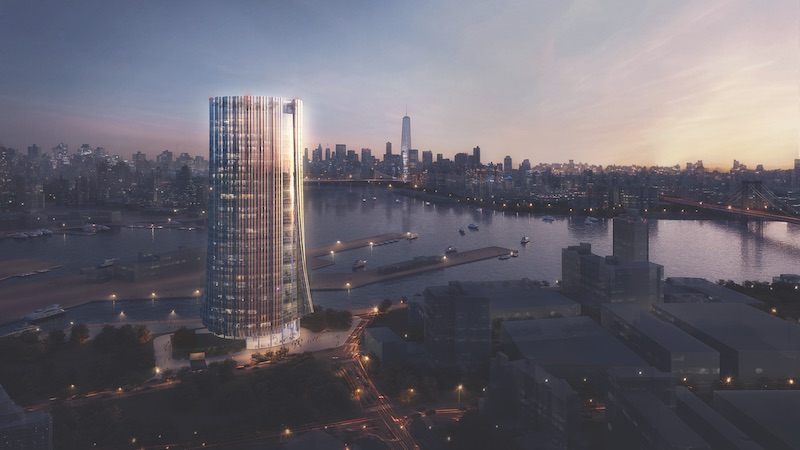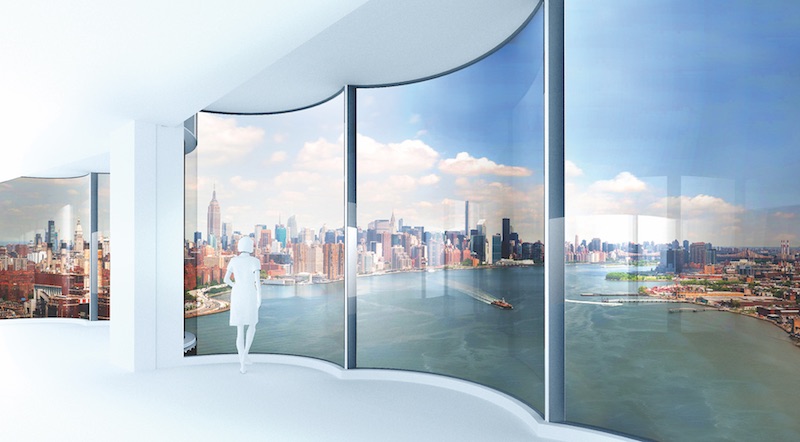New research by interior landscaping firm Ambius (bit.ly/2MPpiy3) found that the typical office worker spends less time outside than prisoners. According to the survey, 35% of office workers spend no more than 15 minutes outside during their day, and only 26% say they spend more than an hour outside each day.
For many office workers, especially those who work in skyscrapers, stepping outside for a break is easier said than done. Is there a way for these workers to feel connected to the outdoors and gain the benefits mother nature provides? HOK seems to think so.
The firm developed the Circadian Curtain Wall concept, which provides building occupants with bountiful natural light and minimizes solar heat gain. The idea was born from a project HOK façade specialist John Neary, AIA, LEED AP, was working on for a load-bearing façade for high-rise buildings. Much of the aluminum was replaced with steel for added strength; Neary evolved the concept by using curved glass, thus giving the building skin more strength and wind resistance.
 Courtesy HOK.
Courtesy HOK.
The curved, bubbled glass of the Circadian Curtain Wall allows building occupants to have wide-angled views of the outdoors while also bringing natural light deep into a building, keeping the occupants connected to the circadian rhythm of night and day.
See Also: Warehouses rise up to serve downtown
The bubbled windows can be combined with an ovoid floor plate to provide a more active benefit for the building and its occupants: external shading. Regardless of where the sun is in the sky, the bubbled windows reduce the surface area exposed to direct sunlight and provide shading to adjacent areas of the façade. At any given moment, a tower with the circadian curtain wall would be 75% self shaded. A equal-sized tower with a traditional rectangular footprint would only be 50% self shaded.
 Courtesy HOK.
Courtesy HOK.
Due to the windows’ convex nature, sunlight would only hit them at a right angle in a limited area, significantly reducing solar heat load. Some external shades would still be needed. In an effort to not spoil the views, Neary and his team proposed using automated shades stored in a ventilated six-inch cavity between an exterior piece of glass and insulated glazing on the interior of the building.
WSP Built Ecology conducted daylighting and energy model simulations and found the Circadian Curtain Wall can reduce energy use by 16%, peak cooling load by 24%, and peak heating load by 27% in a 30-story building.
Related Stories
3D Printing | Sep 13, 2024
Swiss researchers develop robotic additive manufacturing method that uses earth-based materials—and not cement
Researchers at ETH Zurich, a university in Switzerland, have developed a new robotic additive manufacturing method to help make the construction industry more sustainable. Unlike concrete 3D printing, the process does not require cement.
Smart Buildings | Jul 25, 2024
A Swiss startup devises an intelligent photovoltaic façade that tracks and moves with the sun
Zurich Soft Robotics says Solskin can reduce building energy consumption by up to 80% while producing up to 40% more electricity than comparable façade systems.
Great Solutions | Jul 23, 2024
41 Great Solutions for architects, engineers, and contractors
AI ChatBots, ambient computing, floating MRIs, low-carbon cement, sunshine on demand, next-generation top-down construction. These and 35 other innovations make up our 2024 Great Solutions Report, which highlights fresh ideas and innovations from leading architecture, engineering, and construction firms.
Building Technology | Jun 18, 2024
Could ‘smart’ building facades heat and cool buildings?
A promising research project looks at the possibilities for thermoelectric systems to thermally condition buildings, writes Mahsa Farid Mohajer, Sustainable Building Analyst with Stantec.
75 Top Building Products | Apr 22, 2024
Enter today! BD+C's 75 Top Building Products for 2024
BD+C editors are now accepting submissions for the annual 75 Top Building Products awards. The winners will be featured in the November/December 2024 issue of Building Design+Construction.
AEC Tech | Feb 20, 2024
AI for construction: What kind of tool can artificial intelligence become for AEC teams?
Avoiding the hype and gathering good data are half the battle toward making artificial intelligence tools useful for performing design, operational, and jobsite tasks.
Sustainability | Nov 1, 2023
Researchers create building air leakage detection system using a camera in real time
Researchers at the U.S. Department of Energy’s Oak Ridge National Laboratory have developed a system that uses a camera to detect air leakage from buildings in real time.
Resiliency | Aug 7, 2023
Creative ways cities are seeking to beat urban heat gain
As temperatures in many areas hit record highs this summer, cities around the world are turning to creative solutions to cope with the heat. Here are several creative ways cities are seeking to beat urban heat gain.
AEC Innovators | Jun 15, 2023
Rogers-O'Brien Construction pilots wearables to reduce heat-related injuries on jobsites
Rogers-O'Brien Construction (RO) has launched a pilot program utilizing SafeGuard, a safety-as-a-service platform for real-time health and safety risk assessment. Non-invasive wearables connected to SafeGuard continuously monitor personnel to prevent heat exhaustion on jobsites, reducing the risk of related injuries. RO is the first general contractor to pilot this program.
Office Buildings | May 15, 2023
Sixteen-story office tower will use 40% less energy than an average NYC office building
This month marks the completion of a new 16-story office tower that is being promoted as New York City’s most sustainable office structure. That boast is backed by an innovative HVAC system that features geothermal wells, dedicated outdoor air system (DOAS) units, radiant heating and cooling, and a sophisticated control system to ensure that the elements work optimally together.

















